Microneedling, or derma rolling, has drawn interest as a possible hair care and scalp health technique. This site offers a thorough how-to on derma rolling for hair care.
The Science of Derma Rolling: Enhancing Hair Health
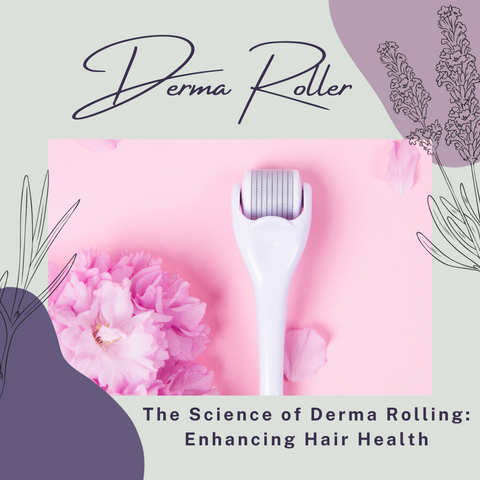
Because microneedling, or derma rolling as it is known in science, can enhance hair health in multiple ways, it has attracted interest. While more research is needed to definitively establish the efficacy of derma rolling, certain scientific results suggest that it may have positive effects on hair health: While these probable pathways suggest that derma rolling may be beneficial for hair health, it's crucial to keep in mind that research is ongoing and that individual outcomes may vary. Furthermore, the safety and efficacy of derma rolling for hair development depend on several factors, including the cause of hair loss, the individual's response, and the proper technique used.
How Derma Rolling Works for Scalp and Hair Rejuvenation
Microneedling, or derma rolling, is a rejuvenating technique for the scalp and hair that uses a specialised instrument with thin needles to create regulated micro-injuries on the scalp. Through several methods, this treatment is thought to encourage the body's natural healing process and maybe encourage hair renewal.
The Ideal Derma Roller: Selecting the Right Needle Size
For safe and efficient use, selecting the appropriate derma roller needle size is essential, especially when thinking about rejuvenating the scalp and hair. Here are some guidelines for choosing the right needle size for hair and scalp rejuvenation, including knowledge of needle sizes, factors to take into account, expert advice, cleanliness, and quality. Never forget to clean the derma roller before and after using it to reduce the possibility of infections or skin irritations.
Every individual's scalp condition varies, so it's essential to be cautious and start with the smallest needle size to assess your scalp's response before considering longer needles, especially if you're performing the procedure at home. Following proper technique, hygiene, and seeking professional guidance can help ensure a safe and effective derma rolling experience for scalp and hair rejuvenation.
Combining Derma Rolling with Other Hair Treatments
The effectiveness of derma rolling in promoting the health of the scalp and hair may be increased when combined with other hair treatments. The following are some ways to combine derma rolling with other treatments: topical hair growth products; low-level laser therapy (LLLT); hair oils and scalp treatments; professional treatments; and scalp nutrition and vitamins. It is imperative to adhere to the guidelines and recommendations provided by healthcare specialists when combining derma rolling with other hair treatments. Before combining several treatments, always seek advice from a dermatologist or other licenced healthcare professional to ensure safety, prevent any negative effects, and optimise the advantages for the health of your scalp and hair.
Practical Guide to Derma Rolling at Home
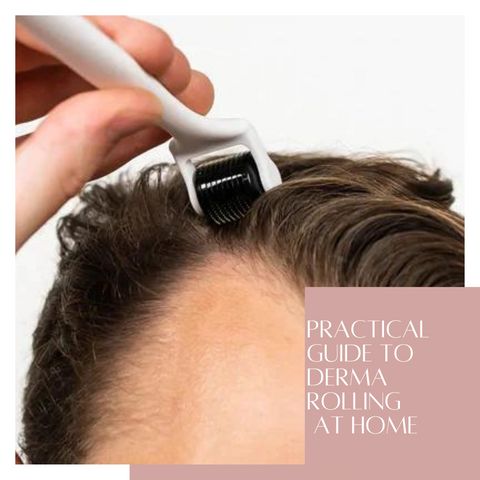
Derma rolling, also known as microneedling, requires proper technique, hygiene, and safety precautions when performed at home to ensure effectiveness and minimise the risk of complications. Here's a step-by-step guide to derma rolling at home:
-
Sanitize the Derma Roller: Before and after each use, disinfect the derma roller by soaking it for 5-10 minutes in rubbing alcohol or a disinfectant solution. Following that, rinse it with hot water.
-
Section Your Scalp: Divide your hair into sections with clips or hair ties to expose the targeted areas of the scalp.
-
Gently Roll the Scalp: Start at the front or crown of your head and gently roll the derma roller vertically, horizontally, and diagonally over each section of the scalp, applying mild pressure. Avoid pressing too hard to prevent discomfort or injury.
-
Maintain Consistent Movements: Roll the derma roller evenly in one direction, avoiding back-and-forth movements to avoid causing damage to the scalp.
-
Focus on Problem Areas: Pay extra attention to areas with hair thinning or where you seek improved hair growth. Be cautious around sensitive areas.
-
Follow a Pattern: To avoid missing spots, make sure you systematically cover the entire scalp, working through each section with overlapping strokes.
-
Apply Gentle Pressure: Roll with moderate but comfortable pressure. Excessive pressing or dragging of the roller across the scalp can irritate.
Step-by-Step Instructions for Safe Scalp Derma Rolling
A step-by-step guide to safe scalp derma rolling is provided below:
-
Sanitise the Derma Roller: For 5-10 minutes, soak the derma roller in rubbing alcohol or a disinfectant solution. Before using, thoroughly rinse it with hot water.
-
Section Your Scalp: Using clips or hair ties, divide your hair into manageable sections to expose the areas of the scalp you will be targeting.
-
Begin Derma Rolling: Begin at the crown or front of your head. Roll the derma roller vertically, horizontally, and diagonally over the exposed scalp area.
-
Maintain Consistent Movements: Roll the derma roller evenly in one direction over each area, applying gentle pressure. Avoid rolling back and forth in the same spot excessively.
-
Systematic Approach: Ensure you cover the entire scalp methodically, moving from one section to another, and slightly overlap each pass to avoid missing areas.
-
Focus on Problematic Areas: Pay extra attention to areas with hair thinning or concerns regarding hair growth. Be cautious and gentle around sensitive areas.
-
Controlled Pressure: Apply moderate pressure without pressing too hard. The goal is to create micro-injuries without causing discomfort or damage.
-
Completing the Session: Once you've covered the entire scalp, avoid excessive rolling and ensure each section receives a balanced treatment.
Following these step-by-step instructions can help ensure safe and effective derma rolling for scalp health and hair rejuvenation. Consulting a healthcare professional or dermatologist before starting a derma rolling regimen is recommended, especially for those with specific scalp conditions or uncertainties about the procedure's suitability for them.
Frequency and Duration: Maximizing the Benefits of Derma Rolling
The duration and frequency of derma rolling sessions are critical to maximising their benefits for scalp health and hair rejuvenation. Here's a frequency and duration guide to help you get the best results:
Frequency:
-
General Recommendation: The usual recommendation for scalp derma rolling is to schedule sessions roughly once a week or every 7–10 days.
-
Assess Scalp Tolerance: Begin with a less frequent schedule, such as once every 10 days, to assess your scalp's response. Increase the frequency gradually if it is well tolerated and has no negative effects.
-
Tailor Frequency to Scalp Sensitivity: Sensitive scalps may benefit from less frequent sessions (e.g., once every 10-14 days) to avoid irritation. Conversely, those with less sensitivity might tolerate weekly sessions well.
-
Regular Consistency is Key: Consistency is essential for reaping potential benefits. Avoid sporadic or overly frequent sessions that could irritate the scalp.
Duration:
-
Balanced Session Length: Aim for a derma rolling session that lasts about 10-15 minutes. This duration allows for thorough coverage while minimising scalp stress.
-
Adjust Based on Scalp Response: If you experience any discomfort, redness, or irritation during or after a session, consider reducing the duration or frequency of derma rolling.
-
Avoid Prolonged Rolling: Avoid excessively long sessions to avoid unnecessary trauma to the scalp, which can result in irritation or damage.
Individual responses may vary, so pay attention to how your scalp reacts and adjust the frequency and duration accordingly. Consultation with a dermatologist or healthcare professional before beginning or modifying a derma rolling regimen can provide personalised advice and ensure the safety of your scalp and overall hair health.
Addressing Hair Concerns: Derma Rolling for Hair Loss and Thickness
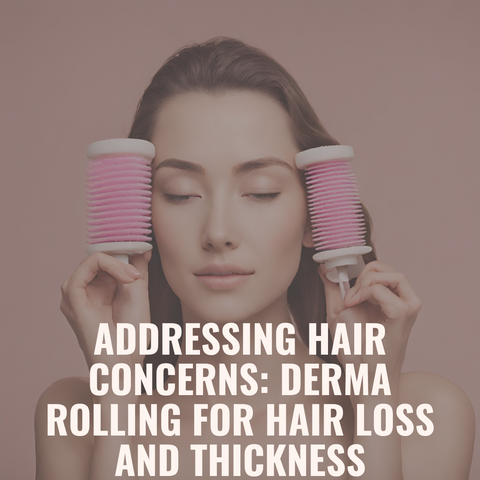
Derma rolling has gained popularity as a potential treatment for addressing hair loss and increasing hair thickness. Here's how derma rolling could help with these issues:
-
Hair Follicle Stimulation: Microneedling has the potential to stimulate dormant hair follicles, encouraging them to enter the growth phase and contributing to hair regrowth.
- Enhanced Absorption of Topical Treatments: The micro-injuries caused by derma rolling may increase absorption of topical hair growth treatments such as minoxidil, thereby increasing their effectiveness.
- Improved Blood Circulation: Microneedling may increase blood flow to the scalp, promoting nutrient and oxygen delivery to hair follicles and potentially supporting healthier follicle function.
- Collagen Production and Tissue Remodeling: Stimulating collagen production through microneedling might create a more conducive environment for hair growth by improving scalp health.
- Hair Thickness:
- Stimulating Hair Follicle Strength: Microneedling can promote collagen production and potentially strengthen the hair follicles, contributing to thicker and more resilient hair strands.
- Enhanced Absorption of Hair:Thickening Products: Derma rolling, like topical treatments for hair loss, may improve the absorption of products designed to thicken hair, potentially optimising their effects.
-
Scalp Health Improvement: Derma rolling may indirectly contribute to healthier hair growth and thickness by stimulating blood circulation and promoting scalp health.
While derma rolling appears to be effective in treating hair loss and increasing hair thickness, individual results may vary. To ensure safety and maximise potential benefits, approach derma rolling for hair concerns with caution, seeking professional guidance and monitoring scalp responses.
Targeting Hair Loss: Can Derma Rolling Be the Solution?
Microneedling, commonly referred to as derma rolling, has drawn interest as a possible treatment for hair loss. Even though it seems promising and might have some advantages, it's critical to comprehend how it might help manage hair loss through stimulating hair follicles, improving topical therapy absorption, enhancing blood circulation, producing collagen, and remodelling tissue.
Consulting a Dermatologist: Seeking advice from a dermatologist or other healthcare provider is advised prior to beginning a derma rolling treatment for hair loss. They may assess your particular condition, identify the reason behind hair loss, and offer advice on whether derma rolling is appropriate and secure for your particular circumstances. In addition, they might suggest a thorough regimen customised to your requirements that includes derma rolling as a tactic to manage hair loss issues.
Boosting Hair Thickness and Volume Through Derma Rolling
Derma rolling, also known as microneedling, has been investigated as a method for increasing hair thickness and volume. While its effectiveness varies by individual, derma rolling may contribute to increased hair thickness via several mechanisms:
-
Stimulation of Hair Follicles: Microneedling causes micro-injuries on the scalp, which may stimulate hair follicles and encourage them to enter the growth phase. This stimulation may result in thicker and stronger hair growth over time.
-
Enhanced Absorption of Hair-Thickening Products: The micro-channels created by derma rolling may improve the penetration and absorption of hair thickening products, such as serums or treatments designed to increase hair volume.
-
Collagen Production and Scalp Health: Microneedling may contribute to a healthier scalp environment by stimulating collagen production and tissue remodelling. A healthier scalp can promote better hair growth and possibly thicker hair strands.
-
Improved Blood Circulation: Increased blood circulation to the scalp can improve nutrient and oxygen delivery to the hair follicles, promoting their health and possibly promoting thicker hair growth.
-
Strengthening Hair Follicles: The micro-injuries induced by microneedling might prompt the body's natural healing response, potentially strengthening the hair follicles and promoting thicker and more resilient hair strands.
While derma rolling has the potential to improve hair thickness and volume, individual results may vary. To maximise potential benefits and minimise risks, approach derma rolling with caution, especially when targeting specific hair concerns, and seek professional guidance.
Post-Treatment Care: Ensuring Effective Recovery and Scalp Health
Following a derma rolling session, post-treatment care is critical to ensure effective recovery and scalp health. Here are some important post-treatment care tips:
-
Gentle Cleansing: To avoid potential irritation, wait at least 24 hours after derma rolling before washing your hair. Use a gentle shampoo to cleanse the scalp without harsh chemicals or fragrances.
-
Avoid Sun Exposure: After derma rolling, protect your scalp from direct sunlight. Wear a hat or use sunscreen to protect the treated area from the sun, as the skin may be more sensitive to it.
-
Hydration and Moisturization: After the treatment, apply a soothing and hydrating product recommended by a dermatologist to calm the scalp and maintain moisture. Look for aloe vera, hyaluronic acid, or a gentle, fragrance-free moisturiser.
-
Avoid Harsh Chemicals: To avoid irritation, avoid using harsh hair care products such as strong shampoos, styling products containing alcohol, or hair dyes for a few days after treatment.
-
Avoid Excessive Heat Styling: Refrain from using heat styling tools (e.g., hairdryers, straighteners) immediately after derma rolling to prevent additional stress on the scalp.
-
Maintain Hygiene: Keep your derma roller clean by sanitizing it before and after each use to prevent infections or skin issues. Rinse it thoroughly with hot water and store it somewhere clean and dry.
-
Monitor Scalp Condition: Watch for any signs of prolonged redness, irritation, or inflammation post-treatment. If these symptoms persist or worsen, seek advice from a dermatologist.
-
Avoid Swimming or Sweating Profusely: Refrain from swimming in chlorinated pools or engaging in activities causing excessive sweating immediately after derma rolling to prevent potential irritation.
-
Follow-up Skincare Routine: After the initial recovery period, resume your regular scalp care routine, ensuring it's gentle and conducive to maintaining a healthy scalp environment.
-
Patience and Consistency: Results from derma rolling sessions for scalp health or hair rejuvenation may take time to become noticeable. Stay patient and consistent with your treatment regimen for potential long-term benefits.
Professional Insights: When to Choose Expert Derma Rolling Services

In some cases, expert derma rolling services provided by dermatologists or trained skincare professionals may be preferable:
-
Seeking professional advice is recommended if you have underlying scalp conditions such as severe alopecia, scarring, or dermatological disorders. Experts can accurately assess the condition and determine whether derma rolling is appropriate or if other treatments are required.
-
If you're new to derma rolling or have concerns about performing it at home, seeking guidance from a professional for the initial sessions can help ensure proper technique, reduce the risk of errors, and provide personalized advice.
-
Professionals can offer advanced derma rolling techniques, such as combining microneedling with PRP (platelet-rich plasma) therapy or other in-office procedures, potentially enhancing the effectiveness of the treatment for certain individuals.
-
Professionals can provide comprehensive treatment plans that may include derma rolling as part of a multi-modal approach for individuals with extensive hair loss, particularly if it is caused by medical conditions or genetic factors.
-
Trained professionals are skilled at maintaining hygiene standards, using appropriate tools, and ensuring the procedure's safety and precision, thereby reducing the risk of complications or adverse effects.
-
Professionals can keep a closer eye on your progress, making changes to your treatment plan as needed and providing ongoing support and guidance throughout the process.
-
Professional services frequently begin with a thorough consultation in which the expert assesses your scalp condition, discusses goals, and customises a treatment plan to your specific needs and concerns.
Professional derma rolling services provide many benefits, but when choosing between in-office treatments and at-home ones, it's important to take your needs, preferences, and budget into account. Whether you're unsure about self-administering derma rolling treatments at home or have complex scalp difficulties, working with a professional can offer a more guided and monitored approach.
The Pros of Professional Derma Rolling Treatments
Derma rolling treatments performed by dermatologists or trained skincare professionals have several advantages:
-
Expertise and Experience: Professionals with extensive training and experience perform derma rolling procedures, ensuring precision, safety, and optimal results.
-
Personalized Treatment Plans: Professionals can tailor treatment plans to individual needs, taking into account specific scalp concerns, hair conditions, and desired outcomes.
-
Accurate Assessment: Dermatologists can accurately assess scalp conditions, identify underlying problems, and recommend the best treatment plan, which may include derma rolling or a combination of treatments.
-
Advanced Techniques and Technology: Professionals have access to advanced derma rolling tools and techniques that may not be available for at-home use, potentially enhancing the effectiveness of the treatment.
-
Safety and Hygiene Standards: Dermatologists adhere to strict hygiene standards and use sterile equipment, lowering the risk of infection or complications during the procedure.
-
Monitoring and follow-up: Professionals can monitor progress, make necessary changes to the treatment plan, and provide follow-up care and guidance throughout the recovery process.
-
Combination Therapies: To maximise results for hair rejuvenation or scalp health, professionals frequently combine derma rolling with other treatments such as PRP therapy or specialised serums.
-
Availability of Medical-Grade Products: Professionals may provide access to medical-grade products or formulations that can supplement and enhance the derma rolling treatment.
-
Comprehensive Consultation: Professionals conduct thorough consultations before the procedure, discussing expectations, potential risks, and post-treatment care to ensure informed decisions and patient satisfaction.
-
Case Management in Complex Situations: Professionals can provide comprehensive care plans and holistic approaches that go beyond derma rolling alone for complex scalp conditions or extensive hair loss cases.
While professional derma rolling treatments provide these benefits, they may be more expensive than at-home treatments. Individual preferences, the severity of scalp concerns, and the need for personalised care and guidance should all be considered when deciding between professional services and at-home treatments. Consultation with a dermatologist or skincare professional can assist in determining the best approach for your specific scalp and hair needs.
Navigating the Choice Between Home and Professional Derma Rolling
Choosing between home derma rolling and professional treatments necessitates taking into account several factors to determine the best option:
Home Derma Rolling:
Pros:
-
Perform treatments at your convenience and in the comfort of your home.
-
In the long run, less expensive than professional treatments.
-
You have complete control over the procedure and have complete privacy during sessions.
-
Simple access to regular sessions based on your availability.
Cons:
-
Without professional guidance, there's a higher risk of errors or improper technique.
-
Lack of professional assessment and tailored treatment plans.
-
Improper sanitation or technique may lead to adverse effects or infections.
-
This may not be suitable for complex scalp conditions or severe hair loss cases.
Professional Derma Rolling:
Pros:
-
Access to trained professionals with expertise and experience.
-
Tailored treatment plans and personalized care based on individual needs.
-
Access to advanced tools and combination therapies for better results.
-
Strict adherence to safety standards and post-treatment follow-up care.
-
Suitable for complex scalp conditions or extensive hair loss cases.
Cons:
-
Professional treatments may involve higher initial costs compared to home treatments.
-
Requires scheduling appointments and may not be as convenient as home treatments.
-
Less control over the procedure compared to performing it at home.
Making an informed decision that fits your treatment objectives, personal preferences, and scalp concerns will be made easier if you weigh these variables and take into account the benefits and drawbacks of each option. Speaking with a dermatologist or other skincare specialist may help you decide between at-home derma rolling and professional treatments.
Personalizing Your Hair Care Journey with Derma Rolling
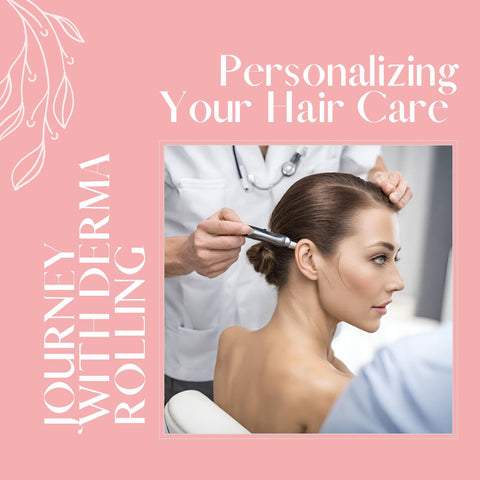
Personalizing your hair care journey with derma rolling involves tailoring the treatment to your specific needs and goals. Here are steps to personalize your derma rolling regimen:
-
Consultation with a Professional: Seek the advice of a dermatologist or trained professional to assess your scalp condition, hair concerns, and whether derma rolling is right for you.
-
Identify Specific Concerns: Determine your primary hair concerns, such as hair thinning, scalp health, or overall hair rejuvenation, to develop targeted derma rolling goals.
-
Develop a Customized Plan: Based on the consultation, collaborate with the professional to develop a personalised derma rolling plan tailored to your specific needs, including frequency, needle size, and targeted areas.
-
Select the Right Products: Choose professional-recommended post-derma rolling products, such as calming serums, growth-boosting treatments, or hydrating solutions tailored to your scalp type.
-
Adjust Frequency and Technique: Adjust the frequency of derma rolling sessions and techniques based on the response of your scalp and the professional's guidance.
-
Combination Therapies: For improved results, consider combining derma rolling with other treatments recommended by your doctor, such as PRP therapy or specific hair growth products.
-
Track Progress and Adjustments: Keep track of your progress, taking note of any changes in hair thickness, scalp condition, or overall hair health. Communicate with the professional regularly and make changes as needed.
-
Consistency and Patience: Maintain consistency with your personalised derma rolling regimen, as results may take some time to appear. Patience and sticking to the treatment plan are essential.
-
Evaluate and Reassess: Reevaluate your goals and results from derma rolling regularly. Discuss any concerns or changes that are required with the professional to ensure ongoing personalised care.
-
Maintain Your Hair's Overall Health: Incorporate a holistic approach to hair care by focusing on a balanced diet, proper hydration, stress management, and the use of appropriate hair care products in addition to derma rolling.
Remember that customising your derma rolling journey entails collaborating with a professional to create a tailored plan that addresses your specific scalp conditions and hair concerns. Following professional advice and tracking progress will help you get the most out of derma rolling for your hair care goals.
Customizing Derma Rolling Techniques for Different Hair Types
The distinctive qualities and requirements of diverse hair textures must be taken into account while tailoring derma rolling processes for different hair kinds. Here are some tips for customising derma rolling for various hair types, including chemically treated or damaged hair, curly or textured hair, thin or fine hair, and thick or coarse hair.
General Hair Care Advice for All Hair Types:
-
To reduce the risk of infections or irritations, make sure your scalp and hair are clean before derma rolling.
-
Use appropriate post-derma rolling products, such as calming serums or hydrating hair solutions, to maintain scalp health and support hair growth.
-
Observe how the scalp reacts after each session and adjust techniques or frequency as needed to avoid irritation or damage.
-
When in doubt or dealing with specific scalp conditions, seek personalised advice from a dermatologist or a skincare professional.
Understanding the distinct characteristics of each hair texture and adjusting the procedure to ensure effective and safe treatment for scalp health and hair rejuvenation entails tailoring derma rolling techniques based on hair type.
Real Stories: Transformative Results with Derma Rolling
Although derma rolling may have advantages for rejuvenating the scalp and promoting healthy hair, each person's experience and outcomes may differ greatly. When derma rolling was added to their hair care regimen, several people had good and even revolutionary benefits. It's crucial to remember that these anecdotal tales are personal accounts and may not apply to everyone. The individual's response, underlying conditions, consistency in the treatment schedule, and the particular techniques and products utilised can all affect the outcome of derma rolling. Furthermore, whereas some people could see improvements, others might not see the same degree of change. For those considering derma rolling, consulting with a dermatologist or healthcare professional can provide personalised guidance and realistic expectations based on individual scalp and hair conditions. Professional guidance can assist in establishing realistic goals and ensuring a safe and effective approach to incorporating derma rolling into a hair care routine.
Conclusion: Integrating Derma Rolling into Your Hair Care Regimen
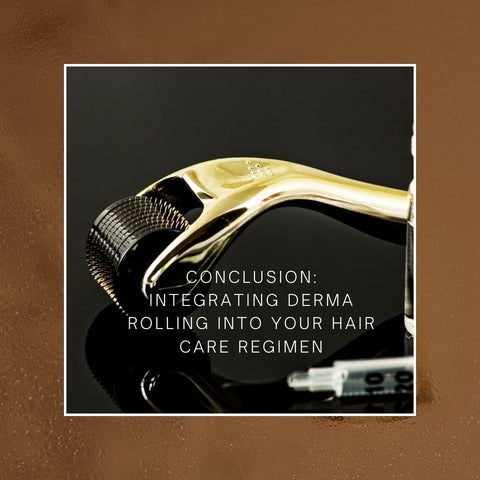
When used carefully and consistently, derma rolling can help encourage hair renewal and possibly improve the condition of your scalp. Although derma rolling has potential benefits for healthy scalp and revitalised hair, results may differ from person to person. It is important to incorporate derma rolling into your hair care routine with caution, paying close attention to technique, consistency, and post-treatment maintenance. Derma rolling may be made as beneficial and risk-free as possible with the assistance of a professional, which will ultimately result in healthier hair and scalp.
































